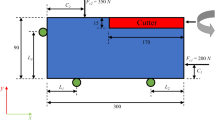Abstract
The design of fixtures is a highly complex process that requires the human designer to draw from his rich experience. In addition, for a given workpiece, multiple solutions may exist. By exploiting the recent advances in CAD/CAM and Artificial Intelligence techniques, one may constrain the multiple solutions such that only good designs (measured through performance measures) are considered.
In this paper, a multi-agent fixture design system is proposed that harnesses the advantages of genetic algorithms and neural networks. This system attempts to capture the relevant domain knowledge and uses it to produce acceptable solutions efficiently. The system is applied to a case problem and the suggested fixturing solution is compared to one offered by a human designer. The agreement between the two solutions is very close.
Similar content being viewed by others
References
Alba, E., Aldana, J. F. and Troya, J. M. (1993) Genetic algorithms as heuristics for optimizing ANN design. Artificial Neural Networks and Genetic Algorithms: Proceeding of the International Conference in Innsbruck, Austria, 683-690.
Arena, P., Caponetto, R., Fortuna, L. and Xibilia, M. G. (1993) M.L.P. Optimal topology via genetic algorithms. Artificial Neural Networks and Genetic Algorithms: Proceeding of the International Conference in Innsbruck, Austria, 670-674.
David, T. and Reid (1991) Fundamentals of Tool Design, Society of Manufacturing Engineers.
Dini, G. (1997) Literature database on application of artificial intelligent methods in manufacturing engineering. CIRP, 46, 681-690.
Dirk, T., Suykens, J., Vandewalle, J. and Moor, B. D. (1993) Genetic weights optimization of a feedforward neural network controller. Artificial Neural Networks and Genetic Algorithms: Proceeding of the International Conference in Innsbruck, Austria, 658-663.
Goldberg, D. E. (1989) Genetic Algorithm in Search, Optimization, and Machine Learning, Addison-Wesley, New York.
Goonatilake, S. and Khebbal, S. (1995) Intelligent hybrid system: issues, classifications and future directions. Intelligent Hybrid System, 1-20.
Kandel, A. and Langholz, G. (1992) Hybrid Architecture for Intelligent System, CRC Press.
Montana, D. J. (1995) Neural network weights selection using genetic algorithms. Intelligent Hybrid System, 85-104.
Munro, P. W. (1993) Genetic search for optimal representation in neural networks. Artificial Neural Networks and Genetic Algorithms: Proceeding of the International Conference in Innsbruck, Austria, 628-634.
Nee, A.Y.C., Whybrew, K. and Senthil Kumar, A. (1995) Advanced Fixture Design for FMS, Springer-Verlag, UK.
Nelson, M. M. and Illingworth, W. T. (1991) A Practical Guide to Intelligent System, Addison-Wesley, New York.
Senthil Kumar A., Subramaniam, V. and Seow, K. C. (1998) Conceptual design using GA. Accepted for publication in International Journal of Advanced Manufacturing Technology.
Ulder, N. L. J., Aarts, E. H. L., Bandelt, H. J., Laarhovan, P. J. M. V. and Pesch, E. (1990) Genetic local search algorithms for the travelling salesman problem. Parallel Problem Solving from Nature, Proceedings from the first Workshop, PPSN I, Dortmund, FRG, 109-116.
Author information
Authors and Affiliations
Rights and permissions
About this article
Cite this article
Subramaniam, V., Senthil Kumar, A. & Seow, K. A multi-agent approach to fixture design. Journal of Intelligent Manufacturing 12, 31–42 (2001). https://doi.org/10.1023/A:1008947413133
Issue Date:
DOI: https://doi.org/10.1023/A:1008947413133




